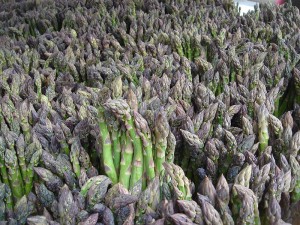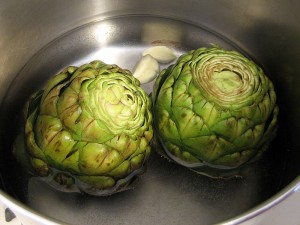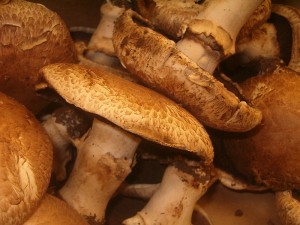When was the last time you read a wine tasting note and found the comment: “This wine pairs great with artichokes, tomatoes, and rice!”?
 Most of us would likely agree that suggestions like this are few and far between. There are many wine drinkers who believe that vegetables and wine do not mix. Often considered the side dish to a more wine friendly entrée—like a gorgonzola-glazed New York steak or Cajun-crusted halibut—vegetables are like the poor cousin in a Jane Austin novel: always invited to the party but never the main attraction.
Most of us would likely agree that suggestions like this are few and far between. There are many wine drinkers who believe that vegetables and wine do not mix. Often considered the side dish to a more wine friendly entrée—like a gorgonzola-glazed New York steak or Cajun-crusted halibut—vegetables are like the poor cousin in a Jane Austin novel: always invited to the party but never the main attraction.
So where then does that leave vegetarians, or people who don’t eat steak, or halibut, or other “wine-friendly” meat dishes? Are they simply the poor cousins of the wine tasting community, forever doomed to lack a full tasting experience that more carnivorously inclined persons enjoy?
The answer, of course, is no. Many vegetarian wine drinkers know that, contrary to popular opinion, not only are there veg-based options for wine, but many that are absolutely delicious. Learning how to make these matches though is beneficial for any wine drinker, even the meat eating ones.
I myself stopped eating red meat and pork over a year ago. I would indulge myself occasionally with chicken or fish, but felt ill every time I chowed down on a piece of bacon or a hamburger. Six months in I stopped eating all meat though my choice was less about ethics and more about being healthy. You probably won’t see me outside a grocery store with a clipboard asking for PETA donations—I don’t like soliciting and their shirts are not my shade of blue.
 With my new diet, I found myself at a bit of a loss as to how to continue with my wine and food pairings without having all the variety that I was used to. How could I pair a Cabernet sauvignon with anything but rosemary chicken or steak? What to do with a buttery Chardonnay without something like succulent prawn pasta? With all these perfect pairings set in my head, I found it almost impossible to imagine these wines with anything else.
With my new diet, I found myself at a bit of a loss as to how to continue with my wine and food pairings without having all the variety that I was used to. How could I pair a Cabernet sauvignon with anything but rosemary chicken or steak? What to do with a buttery Chardonnay without something like succulent prawn pasta? With all these perfect pairings set in my head, I found it almost impossible to imagine these wines with anything else.
I did some research, and tried to find information on how to better match wine with vegetables. Alas, I didn’t find any answers, only more questions! Most people didn’t seem to know any more than I did about these tricky pairings.
So instead I decided to take action. I bought some vegetarian cookbooks, started paying attention to all the ingredients in vegetarian recipes at my restaurant jobs where I served, and got to work. Six months later and many trips to the local Farmer’s Market, I not only successfully created menu options for vegetarians and the veggie-curious, but also found some fabulous wine pairings for them. Here are just a few of the things I learned that might help you along when planning your own vegetarian wine dinners.

First, just about any vegetable can be paired with wine. It’s all about modification and balance between the food and wine. Take a strongly flavored vegetable like asparagus or artichoke for example. Combine them with fire-roasted tomatoes, black peppercorn, and extra virgin olive oil or a garlic lemon Asiago cream sauce to provide a complimentary flavor while keeping the vegetables from seeming too intense. For a suitable wine, try red Burgundy or Zinfandel from coastal California. In contrast, with the Asiago cream sauce, choose a lighter, citrus-driven unoaked Chardonnay.
Next, if you’re looking for a steak substitute look no further than the classic Portobello mushroom. This versatile fungus has a texture much akin to a skirt steak when grilled—and tastes remarkably similar using a teriyaki marinade. Plus, when plated with roasted rosemary potatoes and sautéed baby carrots with cranberry chutney, you’ll have a perfect meal for a rich Cabernet sauvignon.
 Finally, if you need a stand-in for chicken or seafood in a pasta or rice dish, try tofu. Since this soy product is so light in flavor it can be modified to taste like just about anything. If you’re concerned about tofu’s texture, look for the kind that is not packed in water. This does not need to be pressed as much, and you can easily bake it using a variety of spices or marinades. You can also find pre-made soy products to substitute for chicken, ground beef, chorizo, or baked tofu with flavors including teriyaki and curry. A simple pairing with most any pasta dish is Merlot.
Finally, if you need a stand-in for chicken or seafood in a pasta or rice dish, try tofu. Since this soy product is so light in flavor it can be modified to taste like just about anything. If you’re concerned about tofu’s texture, look for the kind that is not packed in water. This does not need to be pressed as much, and you can easily bake it using a variety of spices or marinades. You can also find pre-made soy products to substitute for chicken, ground beef, chorizo, or baked tofu with flavors including teriyaki and curry. A simple pairing with most any pasta dish is Merlot.
So don’t be afraid of trying your own vegetable and wine pairings at home. They offer a new perspective on wine tasting, and create a new challenge in the kitchen as well. Not to mention all the money saved by not buying expensive steak or seafood. If more people start embracing the vegetarian lifestyle in the wine world, the next time you’re in a wine tasting room you may well just come across a note that says “pairs great with artichokes, tomatoes, and rice!” And vegetarians will no longer be the poor cousins but the life of the party.
 Beth Elderkin is the 24-year-old wine blogger behind wino rhino. She lives in Monterey and works as a bartender/tasting room host/wine-loving happy girl. She’ll be attending San Diego State University this Fall to work towards her degree in Journalism.
Beth Elderkin is the 24-year-old wine blogger behind wino rhino. She lives in Monterey and works as a bartender/tasting room host/wine-loving happy girl. She’ll be attending San Diego State University this Fall to work towards her degree in Journalism.

